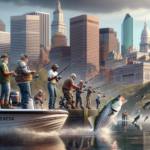Deep-Sea Showdown in California
Introduction
Imagine casting your line into the deep, dark waters off the coast of California, where the ocean’s depths hold secrets and challenges that only the most dedicated anglers dare to uncover. Welcome to the “Deep-Sea Showdown in California,” a thrilling exploration of the best fishing techniques, species, and locations in the Golden State’s offshore waters.
This article will delve into the historical and cultural significance of deep-sea fishing in California, provide a geographical overview of the region, and offer detailed insights into the best fishing techniques, species information, top fishing spots, seasonal considerations, and local events. Whether you’re a seasoned angler or a novice looking to embark on your first deep-sea adventure, this guide will equip you with the knowledge and tools you need for a successful and enjoyable experience.
Why does this matter? Deep-sea fishing in California is not just a pastime; it’s a way to connect with nature, challenge oneself, and potentially reel in some of the most prized catches in the Pacific Ocean. Understanding the best techniques, gear, and locations can make the difference between a memorable trip and a frustrating one.
Background/Context
Historical or Cultural Significance
Deep-sea fishing has a rich history in California, dating back to the early 20th century when sportfishing began to gain popularity. The state’s extensive coastline and diverse marine ecosystems have made it a prime destination for anglers from around the world. Over the years, deep-sea fishing has evolved from a niche hobby to a major industry, contributing significantly to the local economy and culture.
Geographical Overview
California’s coastline stretches over 800 miles, offering a variety of deep-sea fishing opportunities. The region’s climate is generally mild, with cooler waters in the north and warmer waters in the south. The topography includes rocky shores, sandy beaches, and underwater canyons, creating diverse habitats for a wide range of marine species. Key fishing areas include the waters off San Diego, Los Angeles, and the Channel Islands, each offering unique challenges and rewards.
Key Points/Details
Fishing Techniques
Technique Overview
Deep-sea fishing techniques vary depending on the target species and conditions. Common methods include trolling, bottom fishing, and jigging. Trolling involves dragging lures or baited lines behind a moving boat, while bottom fishing targets species near the ocean floor using weighted lines. Jigging uses a vertical motion to attract fish with lures.
When and Where to Use
Trolling is effective for pelagic species like tuna and marlin, especially in open waters. Bottom fishing is ideal for species like rockfish and lingcod, often found near underwater structures. Jigging can be used in various depths and is particularly effective for targeting species like yellowtail and amberjack.
Recommended Gear
- Rods: Heavy-duty rods for trolling and bottom fishing, medium to heavy rods for jigging.
- Reels: High-capacity reels with strong drag systems, such as conventional or spinning reels.
- Lines: Braided lines for strength and sensitivity, with fluorocarbon leaders for stealth.
- Bait/Lures: Live bait like mackerel or squid, artificial lures like jigs, plugs, and trolling lures.
Species Information
Species Overview
California’s deep-sea waters are home to a variety of prized species, including:
- Yellowfin Tuna: Known for their speed and strength, found in warmer southern waters.
- Rockfish: A diverse group of species found near rocky structures and reefs.
- Marlin: Highly sought-after for their size and acrobatic fights, typically found offshore.
- Lingcod: Aggressive predators found near the ocean floor, known for their distinctive appearance.
Best Practices
To successfully catch these species, consider the following tips:
- Yellowfin Tuna: Use live bait or trolling lures, fish during the warmer months, and look for schools of baitfish.
- Rockfish: Use bottom fishing techniques with weighted lines, target rocky areas and reefs, and fish year-round.
- Marlin: Use trolling techniques with large lures, fish in deep offshore waters, and target the summer months.
- Lingcod: Use jigging or bottom fishing techniques, target rocky structures, and fish during the cooler months.
Location Information
Top Fishing Spots
California offers numerous top-tier deep-sea fishing spots, including:
- San Diego: Known for its year-round fishing opportunities and access to species like yellowfin tuna and marlin.
- Channel Islands: Offers diverse fishing opportunities, including rockfish, lingcod, and yellowtail.
- Monterey Bay: Known for its rich marine life and opportunities to catch rockfish and lingcod.
- Los Angeles: Offers access to offshore waters teeming with tuna, marlin, and other pelagic species.
Regulations and Licenses
Before heading out, ensure you are aware of local fishing regulations and license requirements. In California, anglers need a valid fishing license, and specific regulations may apply to different species and areas. Check the California Department of Fish and Wildlife website for the latest information on catch limits, seasonal restrictions, and protected areas.
Seasonal Considerations
Seasonal Variations
Fishing conditions in California can vary significantly throughout the year. Warmer months (June to September) are ideal for targeting pelagic species like tuna and marlin, while cooler months (October to May) are better for bottom-dwelling species like rockfish and lingcod.
Best Times to Fish
The best times to fish depend on the target species and location. Early morning and late afternoon are generally productive times, as many species are more active during these periods. Additionally, fishing around tide changes can increase your chances of success.
Events and Tournaments
Event Overview
California hosts several deep-sea fishing tournaments and events throughout the year, attracting anglers from around the world. Notable events include the Bisbee’s Black & Blue Marlin Tournament in Los Cabos and the Tuna Challenge in San Diego.
Preparation Tips
To prepare for these events, consider the following tips:
- Gear: Ensure your gear is in top condition, with strong lines, sharp hooks, and well-maintained reels.
- Practice: Spend time practicing your techniques and familiarizing yourself with the target species’ behavior.
- Strategy: Develop a strategy based on the event’s rules and the local fishing conditions.
Tips and Best Practices
General Tips
- Research: Study the local fishing conditions, species behavior, and best techniques before heading out.
- Patience: Deep-sea fishing can be challenging, so patience and persistence are key to success.
- Adaptability: Be prepared to adjust your techniques and strategies based on changing conditions.
Avoid Common Mistakes
- Overloading Gear: Avoid using gear that is too heavy or too light for the target species.
- Ignoring Regulations: Always follow local fishing regulations to avoid fines and protect marine ecosystems.
- Neglecting Safety: Prioritize safety by wearing life jackets, checking weather conditions, and having emergency equipment on board.
Advanced Techniques
- Chumming: Use chum to attract fish to your location, especially for species like tuna and shark.
- Live Bait Rigging: Master the art of rigging live bait to increase your chances of attracting larger predators.
- Electronics: Utilize fish finders and GPS systems to locate fish and navigate effectively.
Gear and Equipment Recommendations
Essential Gear
- Rods and Reels: Heavy-duty rods and high-capacity reels for deep-sea fishing.
- Lines and Leaders: Braided lines for strength and fluorocarbon leaders for stealth.
- Bait and Lures: A variety of live bait and artificial lures suitable for different species.
- Safety Equipment: Life jackets, first aid kits, and emergency signaling devices.
Optional Gear/Upgrades
- Fish Finders: Advanced electronics to locate fish and underwater structures.
- Downriggers: Equipment to control the depth of your bait or lures.
- Fighting Belts: Belts to provide support and leverage when battling large fish.
Where to Buy or Rent
You can purchase or rent fishing gear from local tackle shops, sporting goods stores, or online retailers. Notable stores in California include Fisherman’s Landing in San Diego, Bob Sands Fishing Tackle in Los Angeles, and The Longfin in Orange.
Safety and Conservation
Safety Tips
- Weather: Always check weather conditions before heading out and be prepared for sudden changes.
- Life Jackets: Wear life jackets at all times, especially in rough waters.
- Emergency Equipment: Carry a first aid kit, signaling devices, and a VHF radio for emergencies.
Conservation Practices
- Catch and Release: Practice catch and release for non-target species and follow guidelines for safe handling.
- Respect Wildlife: Avoid disturbing marine life and habitats, and dispose of waste properly.
- Follow Regulations: Adhere to local fishing regulations to protect fish populations and ecosystems.
Planning Your Trip
Accommodations
Consider staying at hotels or lodges near popular fishing spots. Notable options include the Bahia Resort Hotel in San Diego, the Channel Islands Inn in Oxnard, and the Monterey Plaza Hotel & Spa in Monterey.
Travel Tips
- Routes: Plan your route to the fishing location, considering traffic and road conditions.
- Transportation: If you don’t have a boat, consider booking a charter with a reputable company.
- Permits: Ensure you have all necessary permits and licenses before your trip.
Additional Activities
While in California, explore other activities such as whale watching, surfing, hiking, and visiting local attractions like the San Diego Zoo, Channel Islands National Park, and Monterey Bay Aquarium.
Frequently Asked Questions (FAQs)
What is the best time of year for deep-sea fishing in California?
The best time for deep-sea fishing varies by species. Summer months (June to September) are ideal for pelagic species like tuna and marlin, while cooler months (October to May) are better for bottom-dwelling species like rockfish and lingcod.
Do I need a fishing license for deep-sea fishing in California?
Yes, a valid California fishing license is required for deep-sea fishing. Additional regulations may apply depending on the species and location.
What safety precautions should I take when deep-sea fishing?
Always check weather conditions, wear life jackets, carry emergency equipment, and follow safety guidelines provided by your charter or local authorities.
Can I rent fishing gear in California?
Yes, many local tackle shops and charter companies offer gear rentals. It’s advisable to check availability and reserve equipment in advance.
Conclusion
Deep-sea fishing in California offers an exhilarating experience for anglers of all skill levels. By understanding the best techniques, species, locations, and seasonal considerations, you can enhance your chances of a successful and enjoyable trip. Remember to prioritize safety, follow local regulations, and practice conservation to ensure the sustainability of this incredible sport. So gear up, plan your trip, and get ready for an unforgettable deep-sea showdown in California!


